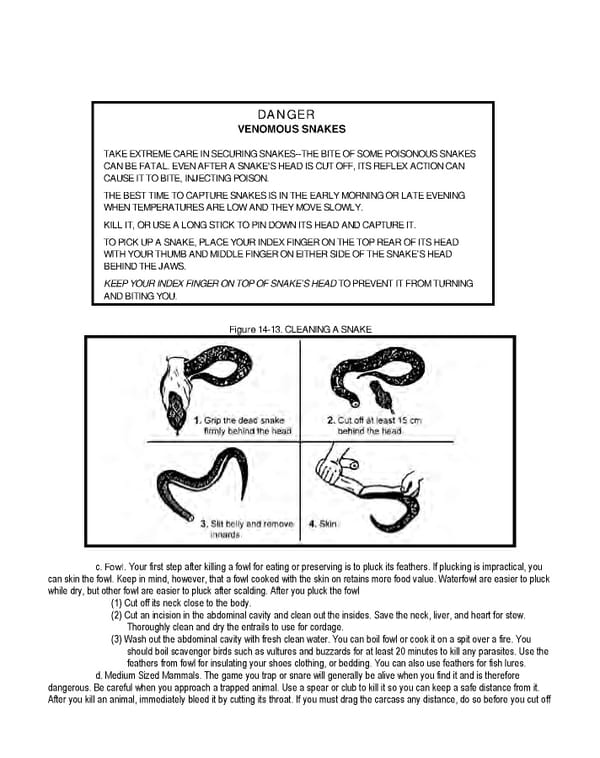DANGER VENOMOUS SNAKES TAKE EXTREME CARE IN SECURING SNAKES--THE BITE OF SOME POISONOUS SNAKES CAN BE FATAL. EVEN AFTER A SNAKE'S HEAD IS CUT OFF, ITS REFLEX ACTION CAN CAUSE IT TO BITE, INJECTING POISON. THE BEST TIME TO CAPTURE SNAKES IS IN THE EARLY MORNING OR LATE EVENING WHEN TEMPERATURES ARE LOW AND THEY MOVE SLOWLY. KILL IT, OR USE A LONG STICK TO PIN DOWN ITS HEAD AND CAPTURE IT. TO PICK UP A SNAKE, PLACE YOUR INDEX FINGER ON THE TOP REAR OF ITS HEAD WITH YOUR THUMB AND MIDDLE FINGER ON EITHER SIDE OF THE SNAKE’S HEAD BEHIND THE JAWS. KEEP YOUR INDEX FINGER ON TOP OF SNAKE’S HEAD TO PREVENT IT FROM TURNING AND BITING YOU. Figure 14-13. CLEANING A SNAKE c. Fowl. Your first step after killing a fowl for eating or preserving is to pluck its feathers. If plucking is impractical, you can skin the fowl. Keep in mind, however, that a fowl cooked with the skin on retains more food value. Waterfowl are easier to pluck while dry, but other fowl are easier to pluck after scalding. After you pluck the fowl (1) Cut off its neck close to the body. (2) Cut an incision in the abdominal cavity and clean out the insides. Save the neck, liver, and heart for stew. Thoroughly clean and dry the entrails to use for cordage. (3) Wash out the abdominal cavity with fresh clean water. You can boil fowl or cook it on a spit over a fire. You should boil scavenger birds such as vultures and buzzards for at least 20 minutes to kill any parasites. Use the feathers from fowl for insulating your shoes clothing, or bedding. You can also use feathers for fish lures. d. Medium Sized Mammals. The game you trap or snare will generally be alive when you find it and is therefore dangerous. Be careful when you approach a trapped animal. Use a spear or club to kill it so you can keep a safe distance from it. After you kill an animal, immediately bleed it by cutting its throat. If you must drag the carcass any distance, do so before you cut off
 Ranger Handbook Page 263 Page 265
Ranger Handbook Page 263 Page 265